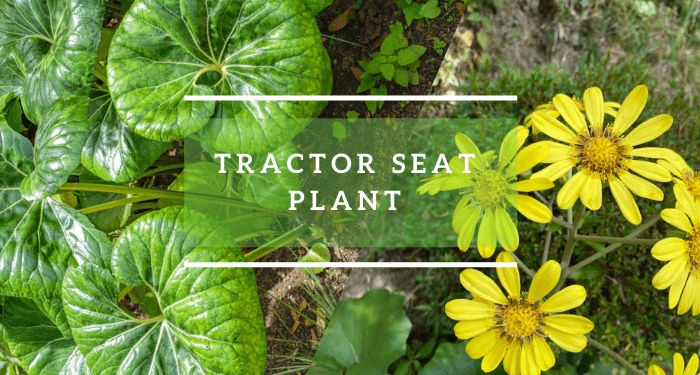Tractor seat plant, have you ever heard of this name? Even if you heard the name of it, do you know what it is ? Many people may not even know that it is a plant.
But in fact it is a plant that you can even use for indoor decoration. It is not the only thing you need to know about this plant, there are a lot of other facts and relevant information you may want to or need to know about this plant.
So, in this article we would like to get you familiar with this plant. So, please read through the whole article so you can get to know all the information about this plants.
What is a Tractor Seat Plant?
The Tractor Seat Plant has its scientific name as The Ligularia reniformis. These plants have lush and giant leaves. These leaves have a shape like a seat. This is hugely popular for its size and glossy foliage.
The Tractor Seat Plant is best in cooler locations, surviving mild frosting, medium winds and full sun.
But it needs to be made sure this plant is watered frequently – it will wilt in dry conditions, but quickly revive when you water it. The Tractor Seat Plant tends to grow in clumps.
A yellow daisy like flower is produced in the Spring season, but it is more highly desired for it’s glossy dinner plate sized foliage. It has a height of 50 cm – 1m in average. The Spread is 50cm – 1m generally.
It has Foliage of medium and large and green.
Tractor Seat Plant Growing Conditions
The plant performs well in sun or partial shade in moist and well-drained soil. Mulching and conservation of natural mulches for example autumn leaves conserves soil moisture during dry times.
Besides, the plant needs protection from any slugs or snails. This evergreen foliage grows in a clump up to about 70cm to 1m tall and wide. In brighter conditions the leaves can become thick and leathery, while in deeper shade the leaves grow even larger and thinner than usual.
Adaptation to light levels is common amongst these plants and is advantageous in shady conditions where foliage is the most effective feature of plants. Though flowering reduces because of lower light levels, bigger foliage of plants compensates.
In summer some clusters of bright orange-yellow daisy like flowers appear above foliage. Some of Ligularia reniformis performs well in the dry zone of holm oak tree, in the lower botanic garden camellia collection.
see more Striped German Tomato
Tractor Seat Plant Problems
Though tractor seat plants can tolerate some sun, it is prone to too much direct sunlight. Ligularia is great planted as a specimen plant but can also be used as a ground cover.
This plant is slow to spread and produce new plantlets very slowly than we expect. But Plants needs to be spaced at 18 to 24 inches apart as these specimens become established, they will put off more, larger foliage and new plantlets that will eventually fill in the area between the plants.
It typically blooms in late summer to fall with stems of yellow flowers that can reach up to 2 fee. Flowers can be up to 1 inch in diameter and are present on the stem.
Also, the plant has very few insect or disease problems except for leaf-eating insects. Still, these can become hugely problematic to the foliage of Ligularia in the late summer.
Tractor Seat Plant Care
It does have one drawback which is winter but it’s totally normal for tractor seat plants to suffer a little in winter. The frost causes damage and plants grow back in the spring time.
In native environment these plants are winter dormant. The Christchurch climate is suitable for them and dependent on their placement at any garden they will either hibernate over winter if they are frosted.
If you protect them they tends to look great all year round. If your tractor seats get frosted its best to leave the burnt foliage on for as long as you can look at it as it will provide some protection to plant for winter.
In springtime cut damaged foliage back to ground level and you can see the new growth. Once cutting the damaged foliage off recommendation is to apply good 12 month slow fertilizer and slug bait to reduce any damages.
see more Husky Cherry Red Tomato
Tractor Plants Indoor Care
This plant has such beautiful leaves and when we look after them correctly they will continue to grow and thrive in your indoor jungle or garden.
- Moisture: This plant loves to be moisture and will let you know when it needs more water! Watch for wilting leaves – it’s the plant asking for a drink.
- Trim: This plant is super hardy and can survive wind, a little frost and sun. To keep it happy, when it’s the end of winter, give this guy a trim to promote new growth for spring.
- Bright light and sun: If you have a sunny windowsill – this is the plant to go there! This plant loves bright light and morning sun.
Is Tractor Plant Seat Poisonous?
Many species of the family if tractor plants seat proves to be fatal and poisonous. But there is no such proven case for tractor seat plants. Still, for safety measures it’s better to keep the children and pets away from these plants. Also, if you work with it in your garden you should also clean your hands safely.
Final Thoughts
The tractor seat plant is a beautiful but slow growing plant. Not only in some botanical gardens it also adds a lot of beauty to indoor gardens. But this plant needs a lot of proper care and suitable conditions to grow. So you have to maintain the proper guidance to keep the plants growing beautifully.
